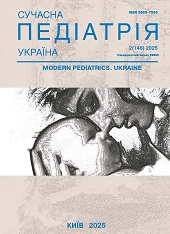Sepsis in children with community-acquired pneumonia: clinical and laboratory features
DOI:
https://doi.org/10.15574/SP.2025.2(146).2631Keywords:
sepsis, community-acquired pneumonia, children, Phoenix score, clinical and laboratory featuresAbstract
Sepsis is a life-threatening organ dysfunction caused by a dysregulated immune response to infection. Despite a decline in mortality among children under the age of five, the fatality rate in older children continues to rise. Sepsis associated with community-acquired pneumonia remains one of the leading causes of hospitalization in pediatric practice.
Aim - to identify the clinical and laboratory features of sepsis in children with community-acquired pneumonia.
Materials and methods. The study included 389 children aged 5-18 years, divided into retrospective (n=214), prospective (n=135), and control (n=40) groups. Disease severity was assessed using the Phoenix scale, which evaluates the function of four organ systems. Statistical analysis was performed using Student’s t-test and Fisher’s exact test (p<0.05).
Results. Children with pneumonia showed significant organ dysfunction: reduced PaO₂/FiO₂, elevated lactate, coagulation activation, and hypotension (p<0.001). In the retrospective group, metabolic disturbances were also reflected by higher lactate and altered hemodynamics. Among patients with ≥4 Phoenix points, severe pneumonia was observed in 80-100% of cases. Increases in C-reactive protein (CRP), leukocytes, erythrocyte sedimentation rate (ESR), nterleukin-1 (IL-1), and interleukin-6 (IL-6) levels correlated directly with illness severity. Тhe incidence of complications-including pleuritis, atelectasis, and need for mechanical ventilation-rose with higher Phoenix scores. In severe cases, hospital stays were 1.4 times longer, while the proportion discharged without complications was 2.5 times lower compared to mild cases.
Conclusions. In children with community-acquired pneumonia, sepsis is accompanied by pronounced organ dysfunction and a systemic inflammatory response. The Phoenix scale is an effective tool for early identification of severe forms of disease, assessment of complication risk, and selection of appropriate treatment strategies.
The study was conducted in accordance with the principles of the Declaration of Helsinki. The study protocol was approved by the Local Ethics Committee for all participants. Informed consent was obtained from patients (parents of children or their guardians).
The authors declare no conflict of interest.
References
Annane D, Ferrer R. (2024). Sepsis from Science to Social Perspective. Seminars in respiratory and critical care medicine. 45(4): 459-460. https://doi.org/10.1055/s-0044-1789249; PMid:39208852
Barry SM. (2025). Rethinking natural product discovery to unblock the antibiotic pipeline. Future microbiology. 20(3): 179-182. Epub 2025 Jan 16. https://doi.org/10.1080/17460913.2025.2449779; PMid:39815788
Hadzhieva-Hristova, A., Krumova, D., Stoeva, T., Georgieva, R., & Iotova, V. (2025). Assessment of Phoenix Sepsis Score, pSOFA, PELOD-2, and PRISM III in Pediatric Intensive Care. Children, 12(3), 262. https://doi.org/10.3390/children12030262; PMid:40150545 PMCid:PMC11941747
Hani E, Abdullahi F, Bertran M, Eletu S, D'Aeth J, Litt DJ et al. (2024). Trends in invasive Haemophilus influenzae serotype b (Hib) disease in England: 2012/13 to 2022/23. The Journal of infection. 89(4): 106247. https://doi.org/10.1016/j.jinf.2024.106247; PMid:39134211
Lanziotti VS, Ventura A, Kache S, Fernández-Sarmiento J. (2024). New Phoenix criteria for pediatric sepsis and septic shock: the strengths and the future of a comprehensive perspective. Critical care science. 36: e20240058en. https://doi.org/10.62675/2965-2774.20240058-en; PMid:39046059 PMCid:PMC11239205
Ministry of Health of Ukraine, State Enterprise "State Expert Center of the Ministry of Health of Ukraine", Association of Pediatricians of Ukraine. (2022). Pneumonia in children: An evidence-based clinical guideline. URL: https://www.dec.gov.ua/mtd/pozalikarnyani-pnevmoniyi-u-ditej/.
Sanchez-Pinto LN, Bennett TD, De Witt PE, Russell S, Rebull MN, Martin B et al. (2024). Development and Validation of the Phoenix Criteria for Pediatric Sepsis and Septic Shock. JAMA. 331(8): 675-686. https://doi.org/10.1001/jama.2024.0196; PMid:38245897 PMCid:PMC10900964
Schlapbach LJ, Watson RS, Sorce LR, Argent AC, Menon K, Hall MW et al. (2024). International Consensus Criteria for Pediatric Sepsis and Septic Shock. JAMA. 331(8): 665-674. https://doi.org/10.1001/jama.2024.0179; PMid:38245889 PMCid:PMC10900966
World Health Organization. (2019). WHO Country Cooperation Strategy 2020-2024: Towards transition. World Health Organization, Country Office for Bhutan. URL: https://apps.who.int/iris/bitstream/handle/10665/339044/9789290227434-eng.pdf?sequence=1.
Downloads
Published
Issue
Section
License
Copyright (c) 2025 Modern pediatrics. Ukraine

This work is licensed under a Creative Commons Attribution-NonCommercial 4.0 International License.
The policy of the Journal “MODERN PEDIATRICS. UKRAINE” is compatible with the vast majority of funders' of open access and self-archiving policies. The journal provides immediate open access route being convinced that everyone – not only scientists - can benefit from research results, and publishes articles exclusively under open access distribution, with a Creative Commons Attribution-Noncommercial 4.0 international license (СС BY-NC).
Authors transfer the copyright to the Journal “MODERN PEDIATRICS. UKRAINE” when the manuscript is accepted for publication. Authors declare that this manuscript has not been published nor is under simultaneous consideration for publication elsewhere. After publication, the articles become freely available on-line to the public.
Readers have the right to use, distribute, and reproduce articles in any medium, provided the articles and the journal are properly cited.
The use of published materials for commercial purposes is strongly prohibited.

